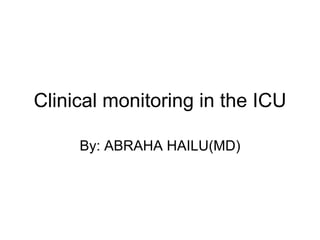Clinical monitoring in ICU
•Download as PPT, PDF•
141 likes•44,029 views
Report
Share
Report
Share

Recommended
Recommended
More Related Content
What's hot
What's hot (20)
Deep hypothermic circulatory arrest in pediatric cardiac sur

Deep hypothermic circulatory arrest in pediatric cardiac sur
Static and dynamic indices of hemodynamic monitoring

Static and dynamic indices of hemodynamic monitoring
CVP Pulmonary artery wedge pressure monitoring: Physiology

CVP Pulmonary artery wedge pressure monitoring: Physiology
Viewers also liked
Viewers also liked (20)
Monitoring of patient in intensive care unit (ICU)

Monitoring of patient in intensive care unit (ICU)
Mobile CRAs: Transforming Clinical Monitoring Processes through Mobile Techno...

Mobile CRAs: Transforming Clinical Monitoring Processes through Mobile Techno...
Robotic Surgery by muthugomathy and meenakshi shetti.

Robotic Surgery by muthugomathy and meenakshi shetti.
INTELLIGENT MOBILE BASED PATIENT MONITORING SYSTEM

INTELLIGENT MOBILE BASED PATIENT MONITORING SYSTEM
Similar to Clinical monitoring in ICU
Similar to Clinical monitoring in ICU (20)
arterial and CVP monitoring in perioperative period.pptx

arterial and CVP monitoring in perioperative period.pptx
central venous pressure and intra-arterial blood pressure monitoring. invasiv...

central venous pressure and intra-arterial blood pressure monitoring. invasiv...
Recently uploaded
Recently uploaded (20)
TrustArc Webinar - Stay Ahead of US State Data Privacy Law Developments

TrustArc Webinar - Stay Ahead of US State Data Privacy Law Developments
Powerful Google developer tools for immediate impact! (2023-24 C)

Powerful Google developer tools for immediate impact! (2023-24 C)
Strategies for Unlocking Knowledge Management in Microsoft 365 in the Copilot...

Strategies for Unlocking Knowledge Management in Microsoft 365 in the Copilot...
ProductAnonymous-April2024-WinProductDiscovery-MelissaKlemke

ProductAnonymous-April2024-WinProductDiscovery-MelissaKlemke
Apidays Singapore 2024 - Modernizing Securities Finance by Madhu Subbu

Apidays Singapore 2024 - Modernizing Securities Finance by Madhu Subbu
Web Form Automation for Bonterra Impact Management (fka Social Solutions Apri...

Web Form Automation for Bonterra Impact Management (fka Social Solutions Apri...
Axa Assurance Maroc - Insurer Innovation Award 2024

Axa Assurance Maroc - Insurer Innovation Award 2024
Repurposing LNG terminals for Hydrogen Ammonia: Feasibility and Cost Saving

Repurposing LNG terminals for Hydrogen Ammonia: Feasibility and Cost Saving
A Beginners Guide to Building a RAG App Using Open Source Milvus

A Beginners Guide to Building a RAG App Using Open Source Milvus
Emergent Methods: Multi-lingual narrative tracking in the news - real-time ex...

Emergent Methods: Multi-lingual narrative tracking in the news - real-time ex...
How to Troubleshoot Apps for the Modern Connected Worker

How to Troubleshoot Apps for the Modern Connected Worker
Strategies for Landing an Oracle DBA Job as a Fresher

Strategies for Landing an Oracle DBA Job as a Fresher
Strategize a Smooth Tenant-to-tenant Migration and Copilot Takeoff

Strategize a Smooth Tenant-to-tenant Migration and Copilot Takeoff
Apidays Singapore 2024 - Building Digital Trust in a Digital Economy by Veron...

Apidays Singapore 2024 - Building Digital Trust in a Digital Economy by Veron...
AWS Community Day CPH - Three problems of Terraform

AWS Community Day CPH - Three problems of Terraform
Clinical monitoring in ICU
- 1. Clinical monitoring in the ICU By: ABRAHA HAILU(MD)
- 11. CVP BLOOD VOLUME (INCREASED VENOUS RETURN RAISES CVP CARDIAC COMPETENCE (REDUCED VENTRICULAR FUNCTION RAISES CVP) INTRATHORACIC AND INTRAPERITONEAL PRESSURE (RAISES CVP) SYSTEMIC VASCULAR RESISTENCE (INCREASED TONE RAISES CVP)
- 31. EQUIPMENT IV extension set to entry port of patients central line. IV giving set to fluid bag. Stopcock (Three way tap)
- 32. DIRECTION OF FLOW The white arrows indicate the direction of fluid flow. (a). Initially the white knob is turned straight up, allowing fluid to flow from the fluid bag to the patient's catheter to assure the catheter is patent.. If fluid does not flow freely into the patient's catheter a valid CVP reading will not be obtained. (b) Then the knob is turned toward the patient and fluid will fill the manometer. The manometer should not contain any air bubbles . If air is present in the manometer or fluid line, let the fluids run, overfilling the manometer until all air is purged from the system. (c) Then turn the knob toward the fluids. The level of fluid in the manometer will fall (the fluid is running into the patient's catheter) until the height of the fluid column exerts a pressure equivalent to the patient's CVP The top of the fluid column will slightly oscillate up and down as the pt’s heart beats and as the pt breathes. a. c. b.
- 33. POSITION OF PATIENT 3-way tap manometer Fluid Bag Patient in supine position Central Venous Access
- 45. M marks the appropriate place for measurement. The bottom tracing shows the overlap tracing with pulmonary artery pressure (PAP). This also can be used for timing the end of diastole and the place to make the measurement. shows a tracing from a young woman who had a major bleed following a hysterectomy
- 47. This indicates severe TR. It must be appreciated that the peak of the v wave, which is 35 mmHg, will still have an important impact on upstream structures such as the liver and kidney
- 51. Cannon A waves
- 52. “ M sign” from Pericardial Constriction
- 74. Components of a Pulmonary Artery Catheter
- 91. INVASIVE HEMODYNAMIC MONITORING
- 97. mmHg
- 120. ASA Guidelines for PAC Use
Editor's Notes
- A wave: right atrial contraction (P wave on the ECG) If the A wave is elevated the patient may have right ventricular failure or tricuspid stenosis. C wave: tricuspid valve closure (follows QRS complex on the ECG). V wave: pressure generated to the right atrium during ventricular contraction, despite the tricuspid valve being closed (latter part of the T wave on the ECG)
- Transparent dressings should be used to permit continuous monitoring of the site. If infection of the CVP line is suspected blood cultures should be taken following removal of the line. The catheter tip should be sent for M C & S.